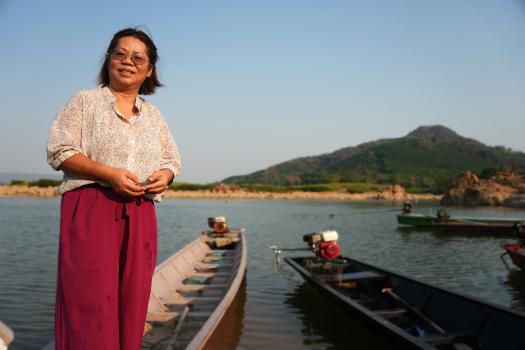Ormbun Thipsuna is speaking up to amplify the importance of conservation of vital water resources. In August 2023, the conservationist began work with the newly formed Hug Mekong Network, a group of civil society organizations in Thailand and Lao People’s Democratic Republic (Lao PDR) that are fostering efforts to protect and restore the Mekong River. Supported by the United States Agency for International Development (USAID) and the World Wide Fund for Nature (WWF) through the Mekong for the Future project, the Hug Mekong Network aims to enhance cross-border collaboration among the countries and provinces that share the river.

“The Hug Mekong Network will be a vital force in elevating the significance of our long-standing research on the Mekong River. With the collected data and information, we can effectively advocate for restoring the Mekong River, which faces severe degradation,” said Ormbun, who represents the Association of Northeast Thailand Community Network, serving seven provinces along the Mekong Basin.
A river providing livelihoods
Stretching nearly 3,000 miles from the Tibetan Plateau to the South China Sea, the Mekong River hosts the world’s largest inland fishery, which yields around 25 percent of the global freshwater catch. The river is home to at least 1,200 freshwater species and supports millions of people in six countries of Southeast Asia. Thus, effectively managing the Mekong’s waters is not only an economic and social imperative but also a political issue, requiring coordinated approaches, dialogue, and cooperation among sectors and countries.
Rapid urbanization, industrialization, and economic development have put immense pressure on the Mekong’s water resources and neighboring communities. Although infrastructure projects drive economic growth, they also cause displacement and change water flow patterns, which leads to declining fish stocks and affects communities and culture. These challenges can lead to transboundary conflicts.

Son Champadok is a fisherwoman and a representative of the Southern Isaan Women Network in Northeast Thailand. She recalled, “I still remember the first time I went fishing when I was just 10, accompanying my dad. He said we had food on our table thanks to the Mekong River. That stuck with me, making me feel a special connection to these waters. We were always out there, fishing every day. Even now, after my dad’s gone, we keep fishing.”
Now in her 40s, Son continues to fish, sustaining the family’s livelihood. Her years of experience have made her the family’s backbone, with a deep understanding of the nuances of the water conditions. This knowledge guided her to successful catches until recently, when she started observing changes in the river.
Inclusive River Governance
USAID and WWF’s technical, financial, and convening support have enabled the creation of the Hug Mekong Network and improved its efficiency. Linda McElroy, Deputy Mission Director of USAID’s Regional Development Mission for Asia (RDMA), explained the goal of the partnership: “USAID recognizes that confronting a changing climate requires us to actively engage with community leaders so that the solutions we develop together are sustainable. This can only happen when actions are locally led, owned, and implemented, and tailored to the unique contexts where we work.”
The network, which takes its name from the Lao word “hug” (“love” in English), is a milestone in cross-border and multi-stakeholder cooperation and reaffirms the importance of public participation in transboundary water governance.
Ormbun said, “I have been working to conserve the Mekong River for 15 years. I have always wanted to work with our brothers and sisters in Laos. However, due to security, budgetary, and lack of proper space, opportunities for dialogue were scarce. The involvement of USAID-WWF partnership as an intermediary transformed what once seemed an unattainable dream into reality.”

Photo credit: Thiti Pleetong
Aod Doungprachan, an advocate and founder of the Green Community Association in Laos, shared, “The river is more vulnerable than ever. Our previous approaches were not effective enough. That is why Thai and Lao civil societies must come together. Whether we face problems that are easily solvable or more complex, we need to learn and tackle these challenges creatively.”
A bright future
The inaugural event of the Hug Mekong Network took place in February 2024 in Nong Khai province, Thailand, and featured restoration activities including planting riverweed (Kaipen) and releasing striped barb fish into the river.
Son made the journey, eager to see how the Network could support women’s economic development. “…We want our Isaan women to develop more stable occupational skills, such as weaving or processing fish… and be able to replace the income lost from fishing,” Son said.
Ormbun described the hope she feels now that the Hug Mekong Network is in place: “It’s heartening to see various sectors coming together under the Hug Mekong Network, united in our mission to restore the environment. Our network is built on something that exists in every community – love. That’s why we call it ‘Hug Mekong,’ which means ‘Love Mekong’ in Isaan dialect. When we channel this love and embrace of the river as our guiding force, the potential impact is boundless.”
This article was developed by USAID’s Regional Development Mission for Asia.


